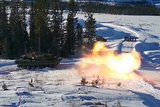Alion to help build geospatial battlefield intelligence
Alion Science and Technology has been awarded a $24 million contract to help the US Army build geospatial battlefield intelligence by providing geospatial enterprise development, integration and evaluation. The work was awarded under the Defense Technical Information Center’s (DTIC’s) Weapon Systems Technology Information Analysis Center (WSTIAC) contract and will run through to January 2016.
The contract will see the company carry out work to generate policy and standards that will guide the use of geospatial data throughout the US Army; developing geospatial data, supporting the testing of geospatially based systems and creating geospatial policy documents.
The US Army’s Geospatial Enterprise (AGE) serves as the knowledge centre for analysis of geospatial information and imagery that represents physical topographies, environmental elements and geographically referenced activities such as geological information, terrain, roads, and the effects of the time of day or weather.
Terri Spoonhour, group senior vice president and manager of the distributed simulation group, said: ‘Alion will help the army to field geospatial enterprise-enabled systems and capabilities to improve efficiency and allow the sharing of geospatial data enterprise-wide. These capabilities include such mission-critical applications as increasing battlefield situational awareness for operational forces across the Department of Defense (DoD), improving training and achieving a common operating environment within the Army Geospatial Enterprise.’
























